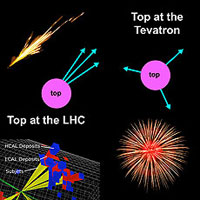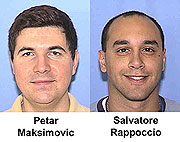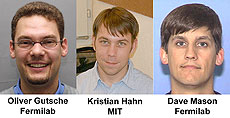Top like you never saw it before
 |
| In the LHC, top quarks will be produced moving very fast. As a consequence, scientists expect the signature for top quark production to be very different than that observed at the Tevatron. These photographs of fireworks serve as a visual metaphor of the qualitative differences between what will be observed at the two accelerator complexes. |
Top quarks were discovered in 1995 at the Tevatron, which is still the only operating particle accelerator capable of creating them. The Tevatron's energy is just high enough to make these very heavy particles. Using his famous equation, E = mc2, Einstein taught us that energy and mass are actually the same thing. Therefore because the top quark's mass is so high, essentially all the Tevatron's energy goes into making it. Very little energy is left over to make the top quark move. Because of this, top quarks are made nearly at rest in the Tevatron.
However, the LHC's design energy is seven times larger than the Tevatron's, which means that making top quarks in the LHC will be easy by comparison. The LHC's extra energy will also be able to make the top quarks move, blasting them out of the collision at a very high energy. Thus, the techniques available to CMS researchers interested in top quarks are quite different than those employed by CDF and DZero.
The majority of the time, top quarks decay into three quarks of lower mass. While waiting for LHC collisions, CMS researchers studied in simulated data how they will search for top quarks in data produced in their detector once the beam turns on. Using an innovative algorithm, the researchers looked for localized energy in their calorimeter with a specific three-lumps structure (one for each quark). Based on their results, researchers are optimistic. For energies above about 15 percent of the expected total collision energy, CMS scientists expect to be to able to identify about half of the top quarks created when LHC collisions begin.
The production of top quarks is a very attractive thing to study. These particles are by far the heaviest subatomic particle and it is thought that this very heavy mass may well serve as a path to finding new physical phenomena. Thus any technique that helps identify top quarks is potentially a crucial contribution to the next big discovery.
For more information, one should look at these slightly advanced, technical, and original theoretical descriptions.
-- Don Lincoln
 |
| These physicists from Johns Hopkins University are the principal authors of this technical study on finding top quarks at the LHC in CMS. They are just a few of the large group of people studying the problem. This group is led by Francisco Yumiceva and Roberto Chierici. |

Fermilab is a Tier 1 site for CMS data. Each Tier 1 center will keep a copy of CMS data sets and the centers form a national computational hub. These physicists are responsible for running data operations at Fermilab's Tier 1 center.
|